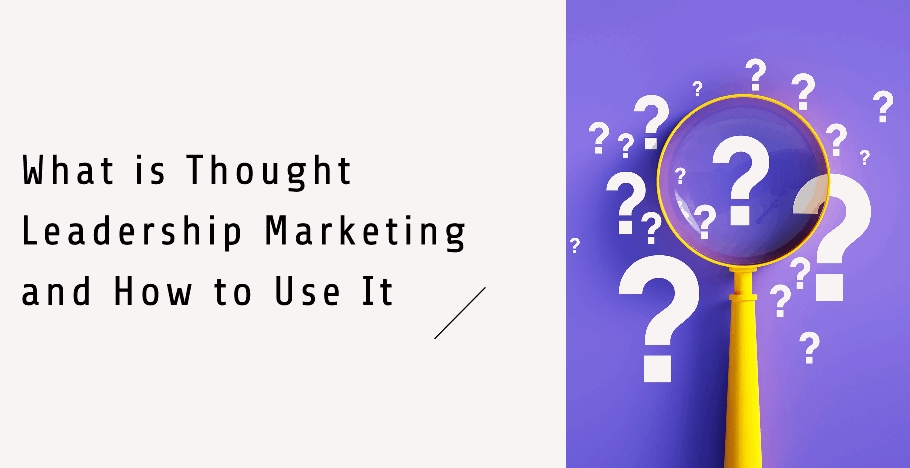Positioning yourself as an authority is a crucial aspect of being an effective digital marketer. And, doing that isn’t possible without producing valuable content on in-demand topics, getting eyeballs on it, generating leads, and establishing a positive reputation. This is where thought leadership comes in. It’s when you position yourself as a leader in your space so that your word carries weight. The result is that more people believe you and are willing to work with you. In this blog post, we’ll talk about everything from what is thought leadership marketing to how to create a thought leadership marketing strategy for any business. Let’s dive in.
What is Thought Leadership Marketing?
Thought leadership marketing is a content marketing strategy that utilizes helpful, in-demand content to build the credibility of a brand. The goal of a thought leadership marketing strategy is to position yourself as an expert and authority on a topic. The strategy involves publishing and promoting valuable content on popular topics in your industry, particularly on social media platforms.
It works by instilling a sense of trust in your prospects’ minds. Thought leaders are taken as an authority. Their followers trust their recommendations, suggestions, and advice. Even if you’re a small business owner, thought leadership through content marketing can help you generate leads and customers in the long run.
Thought Leadership Marketing Best Practices

60% of buyers think thought leadership builds credibility and 57% of them think small and new businesses should work on thought leadership to get more buyers. Thought leadership marketing works on a larger scale, building your trust as a brand, and potentially generating a lot of leads through content. However, you need to stand out with original, unique, and thought-provoking content. Here are a few tips to create an effective thought leadership strategy.
Know and Understand Your Audience
Success with any digital marketing strategy starts with understanding your target audience. This involves creating a buyer persona that describes your target customer in detail. Who are they, what are their pain points, and what motivates and inspires them are questions that help you build your buyer persona. Once you know your audience, you’re in a better position to craft a marketing strategy that generates your desired ROI. To understand your audience, you can conduct interviews, research competitors, and observe social media trends.
You May Also Like: How to Build Reputation with PR
Remain Active on Social Media
Social media content should be the focus of your strategy as it helps you interact with your prospects and customers directly and easily. Also, remain active on all relevant platforms to stay in touch with the latest trends and discussions. Comment on trending industry news to stay relevant and attract more eyeballs to your brand.
Diversify Your Content
Blog posts or articles let you produce in-depth written content, but they don’t cater to all types of audiences. For effective thought leadership, you need to create different types of content, including videos and podcasts, and be active in relevant online communities. The rule of thumb is to create the type of content your target audience likes or spends time-consuming. For instance, if they mostly spend their time on Instagram, investing in long-form blog posts will not help your ROI.
Know Your Competitors
Thought leadership requires consistent content creation and audience engagement. If, at some point, you find yourself struggling to find relevant topics, look at what your competitors are talking about. Use in-depth competitor research to find their best-performing strategies and create a better one. You can also find their weaknesses and avoid making mistakes in your strategy.
Be Genuine
Being too promotional is a mistake many brands make. Your strategy should be to offer a lot of value and build your credibility as a trusted source first. If you’re too promotional with your messaging, you might annoy your prospects and push them away. Plus, make sure your content is backed by research and makes sense to your target audience.
Measure Results

The success of any digital marketing strategy hinges on whether or not it produces the desired results. Measuring the impact of your content is the only way to make sure you’re moving in the right direction. This allows you to make the necessary tweaks if the results are not in your favor, potentially improving your ROI.
You May Also Like: What are the Most Important Digital PR Metrics to Track?
What is Thought Leadership Marketing: FAQs
Let’s answer some popular frequently asked questions about thought leadership marketing.
What are Examples of Thought Leadership?
Plenty of people have used thought leadership to build a following over time. Some examples are Oprah Winfrey, Dave Ramsey, Seth Godin, and Marie Forleo. People follow and listen to these figures and trust them.
What is the Thought Leadership Strategy?
A thought leadership strategy is a roadmap for a person or a company to build authority in a particular field. The strategy involves creating helpful content on popular topics and create a community around your brand.
What is the Difference Between Content Marketing and Thought Leadership?
Content marketing is a broad term catering to everything from blog posts to short videos to podcasts. Whereas thought leadership is an application of content marketing. It involves positioning yourself as an expert on a topic with great content.
How Do You Create an Impactful Thought Leadership Marketing Strategy?
Create a content marketing strategy around trending and popular topics in your industry. Create unique content that stands out and helps you build authority. Be consistent and engage in discussions.
Conclusion
Thought leadership refers to building your influence in a particular industry through helpful, valuable content. In marketing, it refers to influencing your audience’s purchasing decisions by building your authority with consistent, high-quality content. Thought leadership marketers use content marketing principles to win consumers’ trust and grow their business. A successful thought leadership marketing strategy requires:
- Goal setting
- An understanding of your audience
- Competitor research
- Being active on social media
- Content diversity
- Tracking and measurement
Topic expertise and authority are the top benefits of using thought leadership marketing. This is because once you’re an authority, people will start trusting your advice, recommendations, and even promotional messages, which can help you take your business to new heights.
Related Post: What is a Digital PR Agency? (A Complete Guide)




